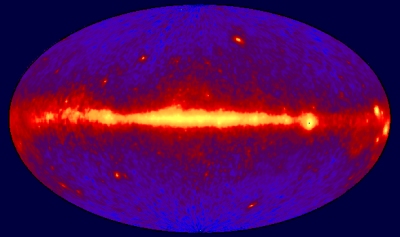Gamma ray
| Wavelength range | m | < 10-11 |
| Frequency range | Hz | > 3×1019 |
| Energy range | eV | > 105 |
 |
|
Whole sky image by the EGRET instrument, aboard the Compton Gamma-Ray Observatory, of gamma rays above 100 MeV. |
Gamma rays are distinguished from X-rays by their origin. Gamma rays are produced in nuclear processes such as radioactivity, or electron-positron annihilation. X-rays are produced by accelerated electrons. There is an overlap between the highly energetic X-rays and the low energetic gamma rays.
In terms of energy gamma rays reside at the far end of the electromagnetic spectrum and can carry energies upward of roughly 100 keV.
To be able to observe gamma rays from objects in the Universe, the detector needs to be above the main part of the Earth's atmosphere because the atmosphere efficiently absorbs the gamma-ray photons. Early observations of gamma rays were done by airborne telescopes on-board airplanes and balloons, and were followed by dedicated satellites in Earth orbit.
ESA Missions
COS-B
ESA's first dedicated satellite Its scientific mission was to study in detail the sources of extra-terrestrial gamma radiation at energies above about 30 MeV. During its nearly 7 year mission an extensive survey of the Galaxy was made in the energy range 50 MeV to 5 GeV.
INTEGRAL
INTEGRAL is the most sensitive gamma-ray observatory ever launched. It studies the highly energetic processes in the Universe in the gamma-ray energy range of 15 keV to 10 MeV and in X-rays with energies between 4 to 35 keV.
Sources of Gamma rays
- Gamma-Ray Bursts: sudden flashes of intense gamma rays that rise steeply and gradually fall off. The source of these flashes is still a topic of ongoing research and range from colliding compact objects to extremely energetic supernovae called hypernovae.
- Compact objects: Neutron stars, white dwarfs
- Active Galactic Nuclei
- Supernovae
- Background: background emission of unresolved gamma-ray sources
